Recent decades saw viral changes in business approaches. The primary trend in those changes is leveraging mobility and clarity. With the tech boom, the business processes speeded up, so businesses needed to adapt and involve flexible approaches. Such methods allow you to quickly adapt to the changing business environment and make the necessary decisions.
Similar transformations came into business planning. Business model canvas replaced lengthy business plans that consume time and considerable resources to develop. Adjusting a business plan as your company evolves would be challenging with this expense. So, business model canvas came to resolve this problem.
Business model canvas is a template helping to develop a strategy for managing your business. It comprises nine blocks covering your audience, resources, partnerships, and other aspects required for your business evolution. This template lets you understand your business progress and make necessary corrections anytime.
This article discusses the concept of the business model canvas and how it helps companies develop. Read on to understand the main blocks and how they will help your business grow.
Business model canvas: definition & structure
A business model canvas is a template that helps business teams to visualize, analyze, and adapt essential aspects of their business. The concept was coined and spread by Alexander Osterwalder, a Swiss entrepreneur and business theorist, and his graduate supervisor Yves Pigneur, a Belgian computer scientist. The term appeared thanks to the contribution of 470 entrepreneurs from 45 countries and was described in Osterwalder’s book Business Model Generation.
The basic idea of the business model canvas is to present a company’s business approach concisely. Thanks to simplicity, it helps teams to grasp the key elements of their business. The business model canvas includes nine areas, such as customer segments, value propositions, customer relationships, and others described in the article.
Now, let’s dive into the details of this model’s building blocks to learn how to create a business model canvas.
Each block of the business canvas model comprises certain information. You can fill them in and show them to your team. You can discuss each fundamental segment together and add the necessary research and data. Let’s see what information you can include in each part of the business model canvas. Below is a video that presents the concept of a business model canvas.
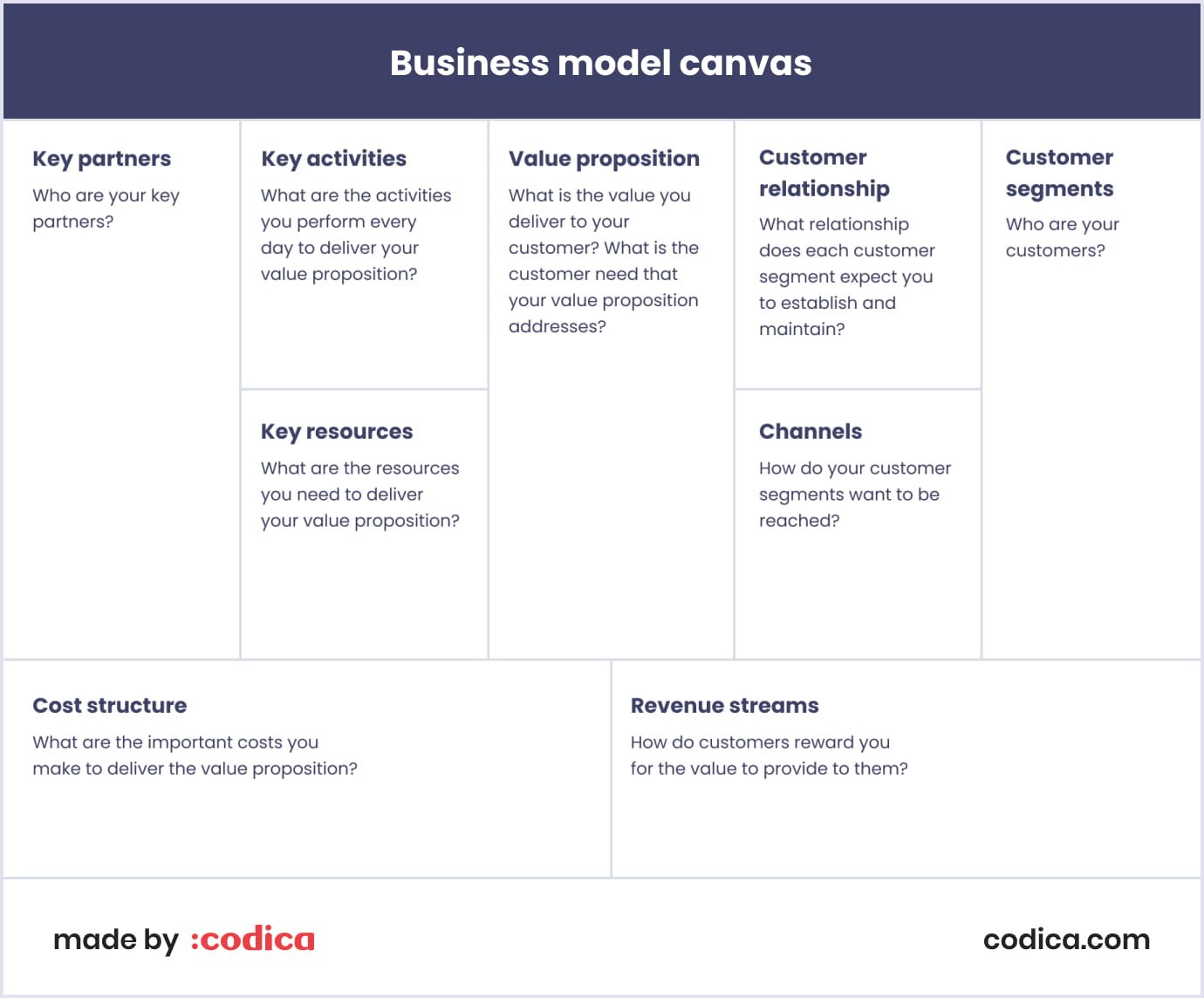
Customer segments
These include users and paying clients that purchase your product. How can you describe your different customer segments? Creating buyer personas to represent your target audience can be helpful.
A buyer persona is a concise but detailed description of a person who buys your product or services. The description shows the customer’s age, goals, interests and represents a specific customer segment. Also, it outlines problems the customer wants to solve and expectations about your product. By describing your buyer persona, you will better understand the pain points you must solve for your customers.
To create a buyer persona, perform research, surveys, and interviews with your prospects or customers. Thus, you will gain data on your customer segments’ expectations and needs.
Value propositions
It is a reason why customers prefer your company instead of others. The value you deliver helps customers satisfy their needs. So, a value proposition is a group of benefits you offer to a particular customer segment. Such benefits can be innovative or add exceptional features to existing products. For example, different value propositions can be as follows:
- Innovative product or service;
- Improved performance;
- Unique design;
- Easier accessibility;
- Convenience in using.
For example, Yelp helps people and local businesses find each other. The company’s value is giving access to reliable information about local businesses. Also, Yelp users can save money when discovering new places. So, the platform provides information that helps connect local businesses and people.
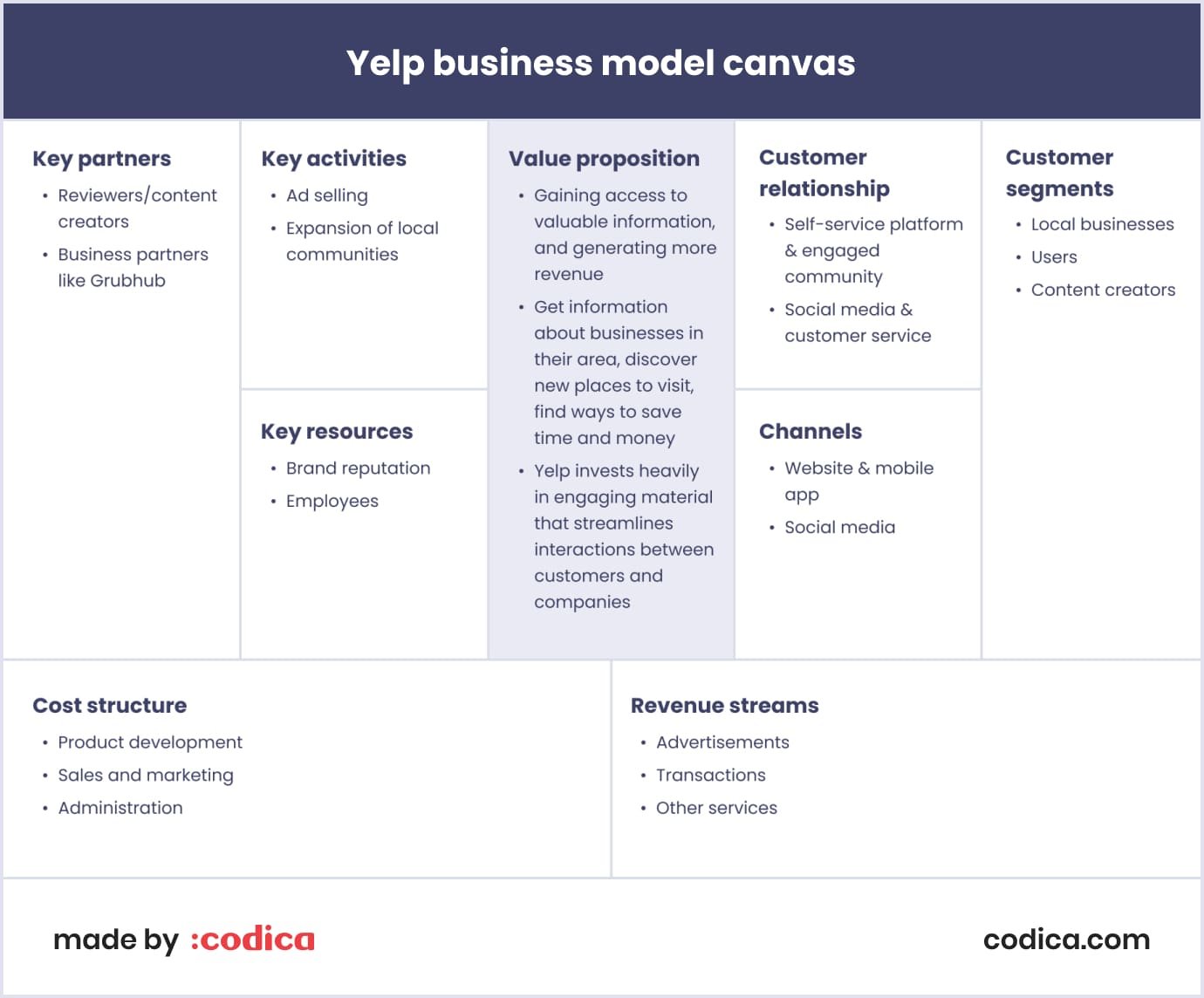
Channels
In a business model canvas, channels are the means to deliver value to your customers. Channels include how a company delivers and distributes products and services. Also, this point includes how an enterprise interacts with customers. Channels should be cost-efficient for your business and common for your customers. So they can notice and buy your product.
Typical channels for a SaaS B2B company include a website or an app.
For example, HubSpot, a customer relationship management system, uses various channels, such as social media, e-mail marketing, and blog. The company also reached its target audience through webinars and tutorials. Thus, their prospects better understood how the HubSpot CRM works.
Customer relationship
This point in the business model canvas outlines how a company will attract, retain and nurture customers. While channels show how to deliver your services, the customer relationship segment emphasizes how you support customers. So, you can use the following approaches to find and build customer relationships:
- Select the channels and platforms that your customers use the most.
- Choose the strategies to attract new customers and retain existing ones. For example, exceptional services and dedicated customer support with direct contact will help you to maintain customer relationships. Also, you can use tiered pricing or discounts for loyal customers.
- Define the ways to grow your audience. You can use content marketing to create blog posts, social media posts, and e-mails highlighting your benefits.
For example, Twitter deals with hundreds of millions of users, so the company needs to respond to their needs. Twitter uses customer service, social media, and e-mail support. These means help the company to maintain the necessary support and growth of their customer base.
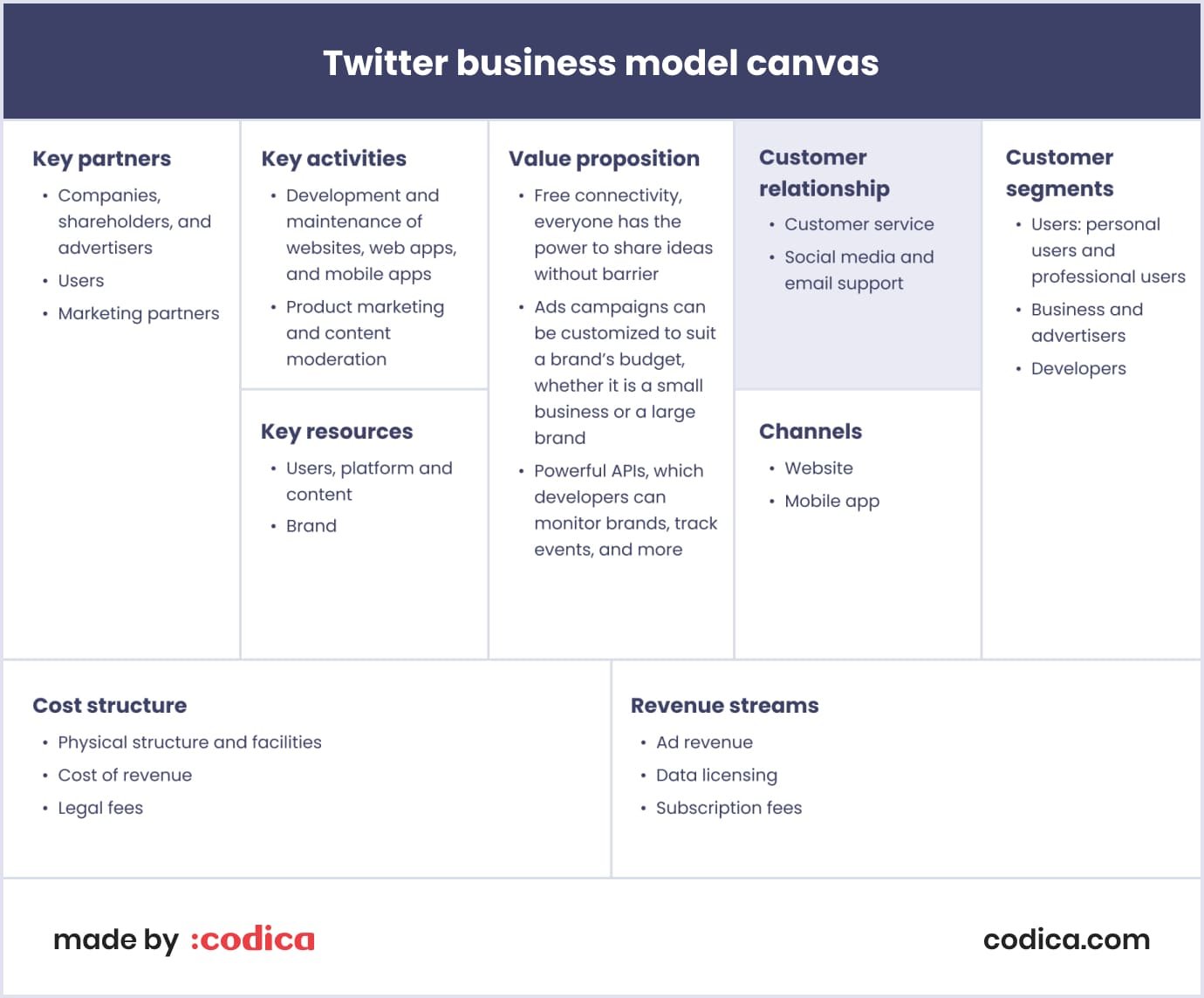
Remember to define key channels for customer relationships through the touchpoints of the customer journey. From attracting to onboarding and support of customers, you will use different channels.
Revenue streams
This section represents the paid flows from your customers who pay for the value you provide. It shows how your business can generate revenue. Knowing this information, a business owner can choose a revenue stream for their product or service and a pricing mechanism. For example, you can choose between the following revenue models for a marketplace:
- Commission monetization model;
- Subscription model;
- Freemium model;
- Featured listings;
- Lead fees;
- Signup fees;
- Advertising fees.
Each revenue stream depends on the specifics of your product or service. You can choose from the above revenue models if you have an online business. Meanwhile, if you have an offline business, you must think about which monetization model you choose regarding the smallest details.

Key resources
Every company has strategic assets that enable its operation. Key resources help you support your value proposition and maintain a connection with customer segments. Companies typically choose resources from the below categories:
- Physical assets, including production facilities, machines, vehicles, and IT systems.
- Intellectual resources, including patents, copyrights, brands, partnerships, and customer databases.
- Human resources, including skilled employees in industries relying on knowledge.
- Financial resources, including cash in bank accounts, credit lines, and stock option pool.
The image below gives a summary of the key resources by category.
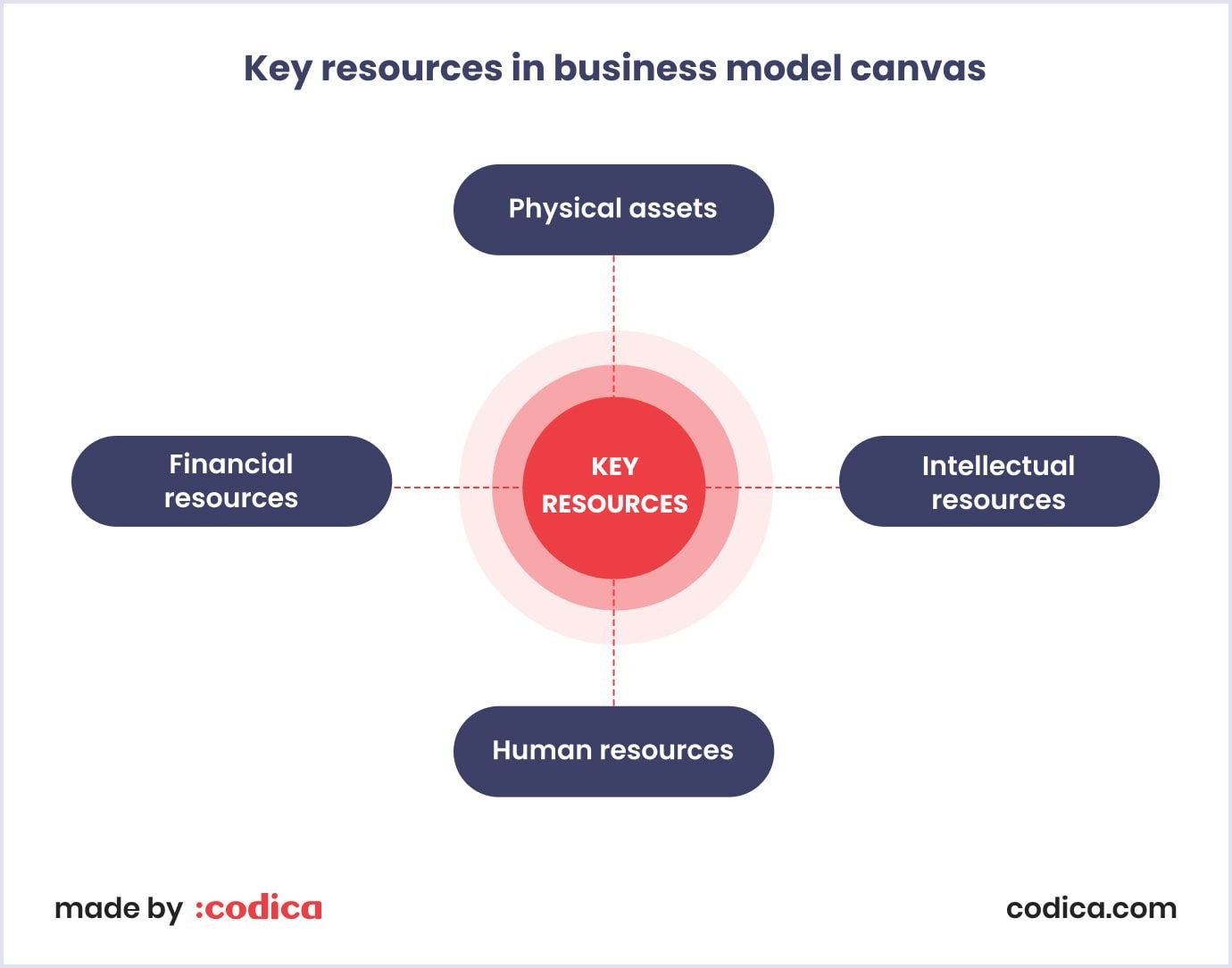
For example, Walmart would use and maintain its physical or virtual infrastructure as its core resources.
Another example is an activity booking marketplace that Codica created. The main asset, in this case, is the platform that enables parents to book activities for their children. The platform allows you to search for activities, book them, schedule with a calendar, and form itineraries for camps with prices. The key resources used in this case are technologies and qualified developers.
Key activities
These are your company's most important endeavors to keep business going successfully. Key activities depend on the niche of your business. For example, the main activities for a boat-selling website that we created include maintaining the platform and managing the interaction between sellers and buyers. Let’s see in more detail what the main key activity groups are as exemplified by this platform.
Production. This is how you deliver your product to end customers. If you create an online product, production includes discovery, design, development, testing, and maintenance of your product. For example, the boat marketplace chose our website redesign services for their platform to receive more conversions. The new design brought the company lead generation growth by 480%.
Problem-solving. These activities involve finding new approaches and addressing customers’ problems. For example, adding new features to your product helps solve your users’ pain points. In the case of the marketplace for boats, it is the decision to create a progressive web application (PWA) for the platform. This helped the company to cover mobile users in addition to desktop users.
Platform/network. These activities dominate companies functioning as platforms. Such enterprises create, run, and promote their platforms as a key resource. A platform that sells products or services requires regular maintenance and updates. For example, the Trade a Boat platform we mentioned above improved its search engine rankings and integrated service for placing ads. Check the video below to see how this boat sales platform works.
Key partnerships
Partnerships are crucial because you can win more with a partner than alone. With key partners, you can delegate specific tasks, mitigate business risks, and optimize your resources. For example, there can be such types of partnerships:
- Buyer-seller partnerships to supply resources or share infrastructure. For example, Alibaba partners with logistics companies to reduce shipping costs.
- Business competitors’ partnerships to mitigate risks and uncertainty. For example, Toyota and Suzuki created an alliance to promote their technologies in electrified transport.
- Partnerships to get access to customers, licenses, or knowledge base. For example, Spotify and Uber partnered to give their customers a better experience while they ride. Thus, both companies reached wider audiences.
To understand if a partner is a key partner, ask yourself: would the business model work without them? If your business model needs this partner to connect business processes, then it is a key partner.
Cost structure
Your costs depend on the expensive key resources and key activities. Some businesses try to minimize costs. At the same time, companies like luxury hotels can be focused on delivering particular value rather than cutting costs. So, your cost structure should be grounded on choosing between spending and value delivery priorities.
Cost structure can be defined based on key resources, key activities, and key partnerships. For example, Tinder, a dating app, spends costs for platform maintenance, salaries, and marketing. Also, the company’s cost structure includes spending on innovations, security, customer support, and product development.
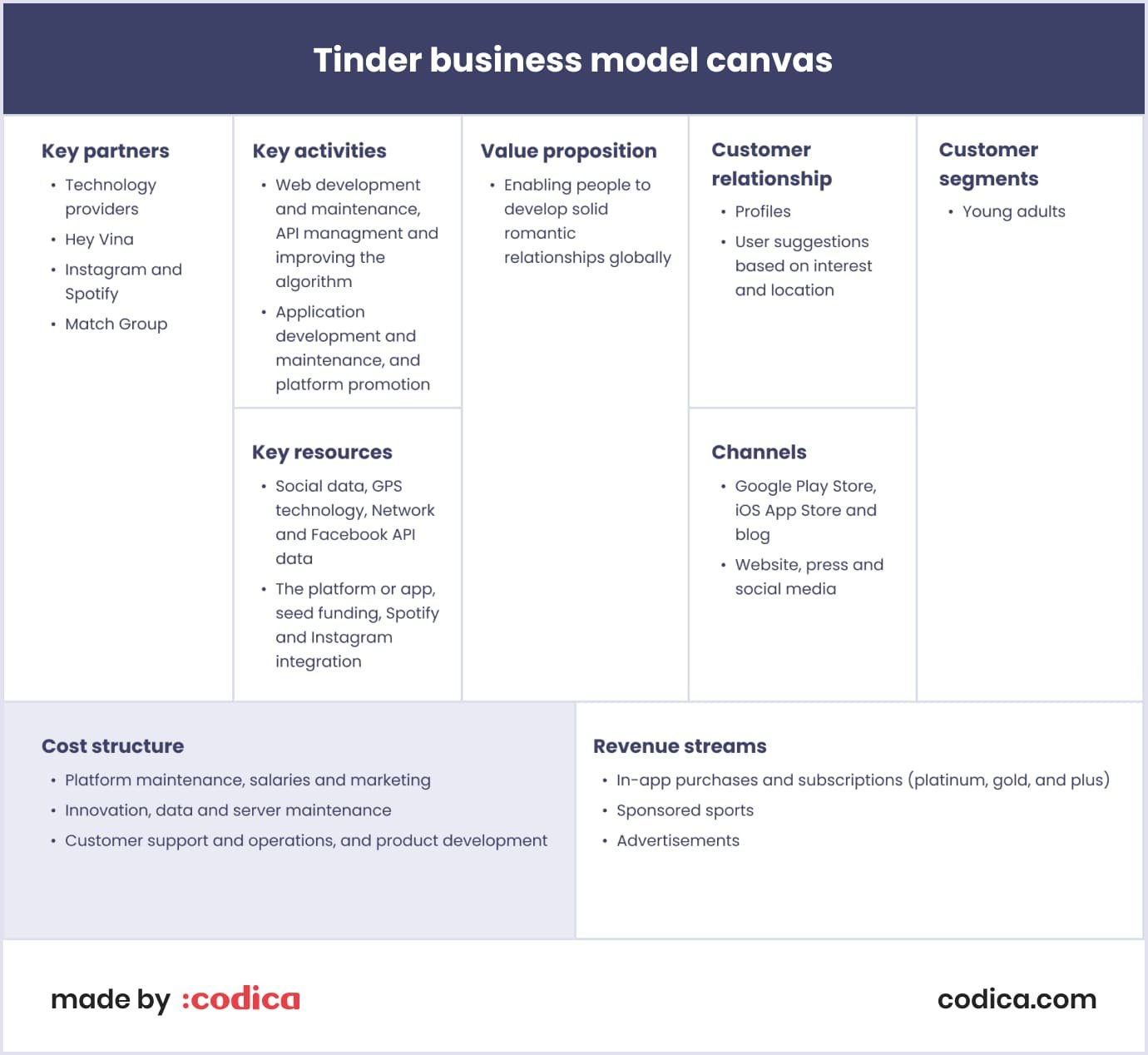
Pros of a business model canvas
Many teams are engaged with current activities to run the business. To develop a successful business, they need a business strategy that provides them with details of where to move. Business model canvas is the right tool to keep them focused on day-to-day tasks with a clear strategy in mind.
But the question is, do you need a business canvas model in the first place? How can you discover if this template suits your business goals? We suggest its pros below.
Presents a concise and easy-to-follow business plan
Whether you are brainstorming business ideas or have a well-grounded venture, the concise strategy will help you plan the future. The business model canvas shows several blocks a team can fill and review at any time. Adjusting it is much easier than modifying a traditional business plan on 100 pages.
Helps to be focused on the action
A business model design focuses on operations and needs to outline actions for the team. For example, you plan to expand your audience or reach a certain profit during the year. Business model canvas is helpful to show you those goals and adjust internal processes if needed.
Enables scalability as the business evolves
Businesses do not remain the same but transform in the market climate. Companies must stay afloat among competitors. Also, they need to adapt to customers’ needs, industry innovations, and market conditions. Thus, you must see how your business plan and revenue goals align with consumers’ needs. A business model canvas is a handy instrument to bring up those aspects for your team. As your company runs, you can make changes and adapt your concise business plan to the current needs.
Puts customers at the forefront
Targeting the right audience is one of the keys for companies to survive. You must choose the right customers for your product to avoid wandering in the market and not reaching your customers. Business model canvas allows your team to understand who your customers are and why your product is valuable to them.
Attracts a team and investors
Any business needs a team with diverse skills and experiences to keep it going. Also, if you want to expand your business, you need to explicitly show your business's capabilities to investors. So, you need a framework that will engage both of these sides. Business model generation helps to outline the value that your company provides. Thus, stakeholders will get a clear view of your company’s perspectives.
Highlights unique value propositions
An outstanding service or feature you offer customers makes them come to you. The unique value proposition explains why customers choose your company among all others. If you look at the business model canvas structure, you will notice that this aspect is at your company's core. If you know your unique value propositions, you will understand other blocks of this template, and they will fall into place.
You may also like: How Much Does It Cost to Build an Online Marketplace in 2023
Business model canvas exemplified by Airbnb
You can find it helpful to see a real-life business model canvas example applied to a business model canvas. Below we illustrate the nine building blocks relevant to the business approach of Airbnb. This is a huge company with a great number of employees. Despite that, the business model canvas is simple and concise. It proves that the approach helps to focus on the main aspects of your business and have a bird’s eye view of business peculiarities. Let’s dive into it.
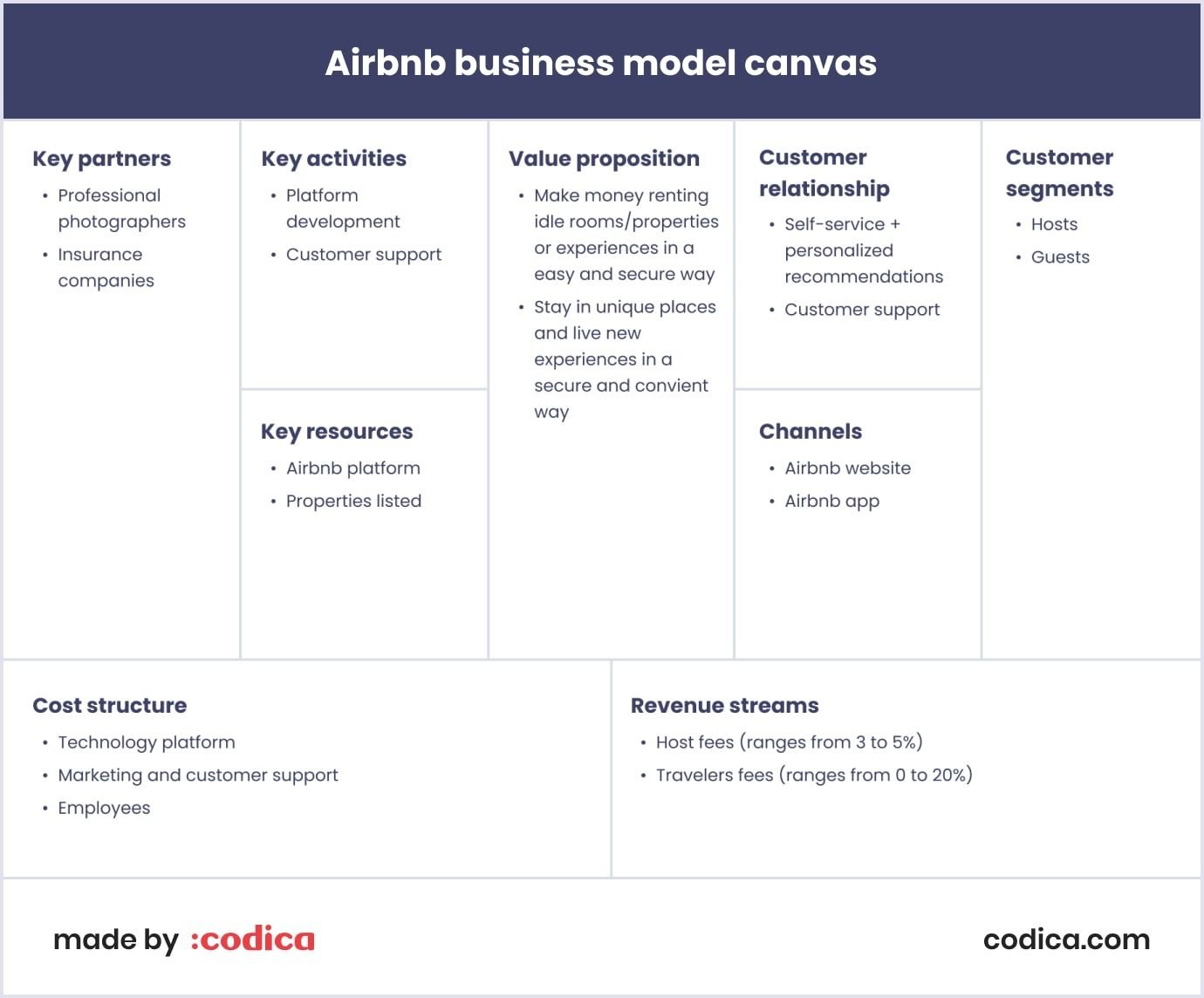
Customer segments: Airbnb customers can be divided into two separate groups: hosts and guests. Hosts differ by the type of property they offer, location, and activities. Guests differ by the type of trip they take and their interests in activities.
Value propositions: the primary reason why users choose this platform is to rent property simply and reliably. The value proposition for hosts includes income generation and risk minimization with insurance. Hosts can easily join the platform and manage their accounts. On the other hand, guests value this resource for the opportunity to stay in new places or while they are on a trip. Often, it is cheaper compared to hotel services.
Channels: the Airbnb platform operates through two channels: website and app. These channels help Airbnb connect the customer segments. Also, Airbnb reaches new customers through social media, digital advertising, and referral program. Many users simply trust the word of mouth and personal recommendations of the hosts. It is remarkable that Airbnb does not use travel agencies as its channels.
Customer relationship: the platform allows hosts to rent out the property on the conditions hosts choose and agree with guests. Also, the platform offers personalized property suggestions and customer support for both parties. The company maintains its reputation through the strong support of communication between customer segments and managing conflicts.
Revenue streams: Airbnb charges a commission from hosts of 3%-5% per deal and guests of up to 20%. More expensive reservations require less commission. As of 2022, Airbnb’s revenue made 8.4 billion, which is a record for the company.
Key resources: key assets for Airbnb are its platform and listed properties. The company makes it possible for guests and hosts to use them. Also, Airbnb’s resources include technologies and engineering staff to support the platform.
Key activities: these are website support and customer nurturing. For example, by developing the category of Superhost, Airbnb encourages hosts to provide better service. This, in return, will attract more guests to the platform. The company acquires new users through sales and marketing and ensures platform security. Also, Airbnb intermediates conflicts arising between hosts and guests.
Key partnerships: Airbnb’s key partners are hosts, including Superhosts. They list their property and attract guests. The company’s key activity is maintaining its website. So, its key partners are technology firms offering relevant software to list the property and manage bookings.
Airbnb’s partnerships also involve cooperation with charity organizations, such as the Red Cross, and support of animal protection initiatives. Besides, Airbnb partners with the Adventure Travel Trade Association to give hosts and guests tips on outdoor activities and adventures. Thus, Airbnb also improves customer relationships.
Cost structure: Airbnb supports its website, so the technologies and employees require spending. Also, the costs include giving away resources on marketing and customer support. Other Airbnb’s spendings cover customer acquisition, insurance, and administrative costs.
You may also like: An Online Marketplace Marketing Strategy That Works in 2023
Key steps in creating a business model canvas
Filling the business model canvas takes several steps. Moving with these steps, you will get insights into the nine elements. We listed the crucial steps in the image below.
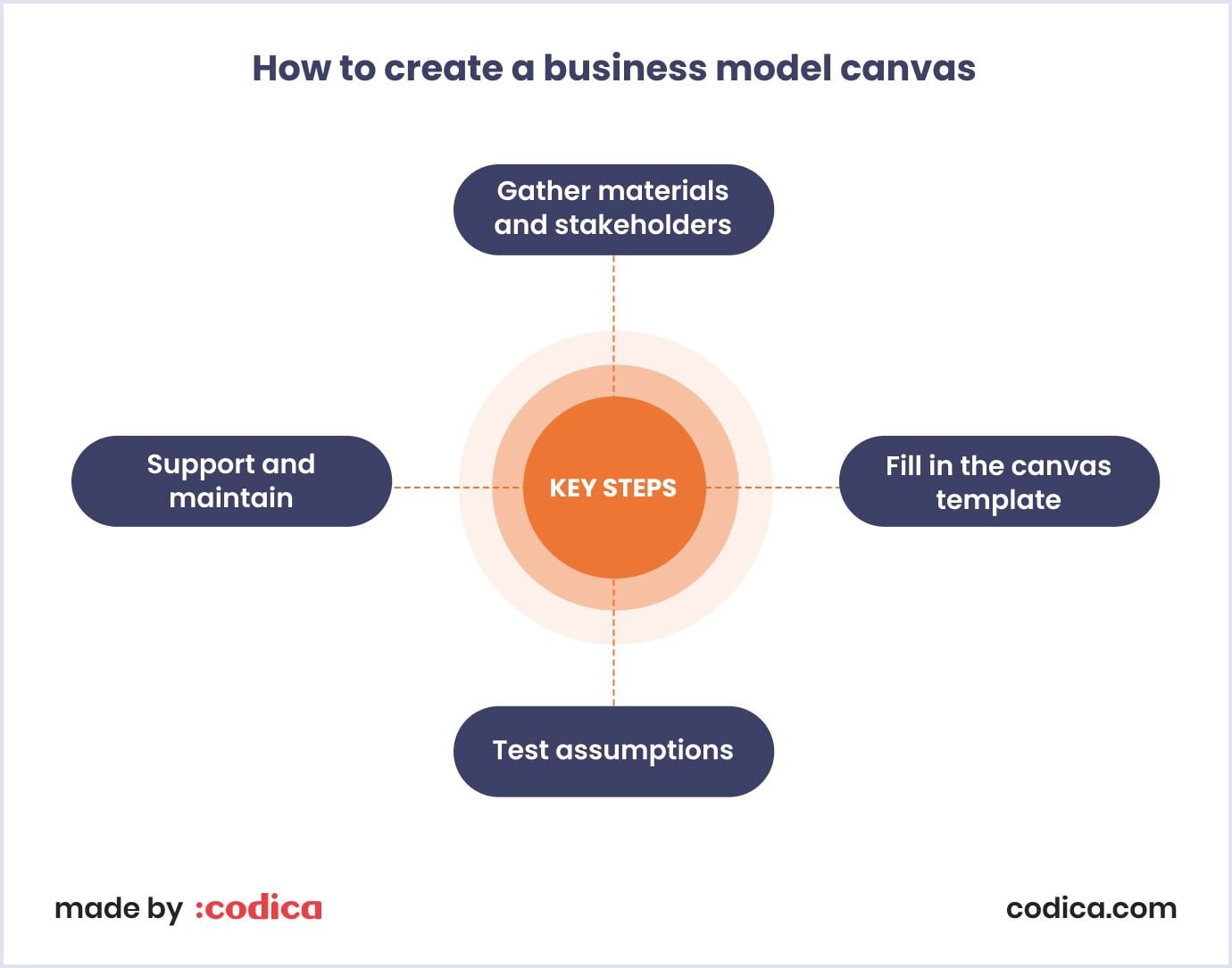
Now, let’s see what these steps imply.
1. Gather materials and stakeholders
Developing a business model canvas involves many teams, such as marketing, sales, and project managers. Participation of the company’s top management, investors, and the business development department is also advisable. This collaboration will bring up the vision of the necessary business aspects. You and your teams will know where to move further by defining them.
Also, you will need research and data on your industry, target audience, and competitors. These valuable data sources will help you correctly fill the business model canvas.
2. Fill in the canvas template
Representatives of the necessary teams can together decide on the vital aspects of the business model canvas. You do not need to make a thorough plan at this stage. You add the essential data to form the direction for your company and teams. If required, you can adjust data later as your business evolves.
3. Test assumptions
The filled business model canvas can be changed at any time. This is the main benefit of this tool. By trying assumptions, your team can develop new ideas and discover that the filled data can be replaced. For example, you can choose other key partners with more competitive conditions. Or your revenue streams can be adjusted with alternative paid methods.
4. Support and maintain
A business model canvas is often seen as a planning method. But you can get more use of it. As your team gets new ideas, fill in your canvas to keep it up-to-date. In case of significant changes, you can rewrite it on the whole. An updated business model canvas is a powerful tool to realize how you will develop your business. You can also show it to stakeholders to obtain investments. In any case, it is a multifaceted and flexible asset.

Project discovery as the most crucial step in creating BMC
Creating a business canvas is crucial to define your business development strategy. But how can you start by outlining the vital points for this? At Codica, we rely on the product discovery process. This step in custom software development service is crucial to identify the project requirements. As a result, a client gets an estimation of project development terms and costs.
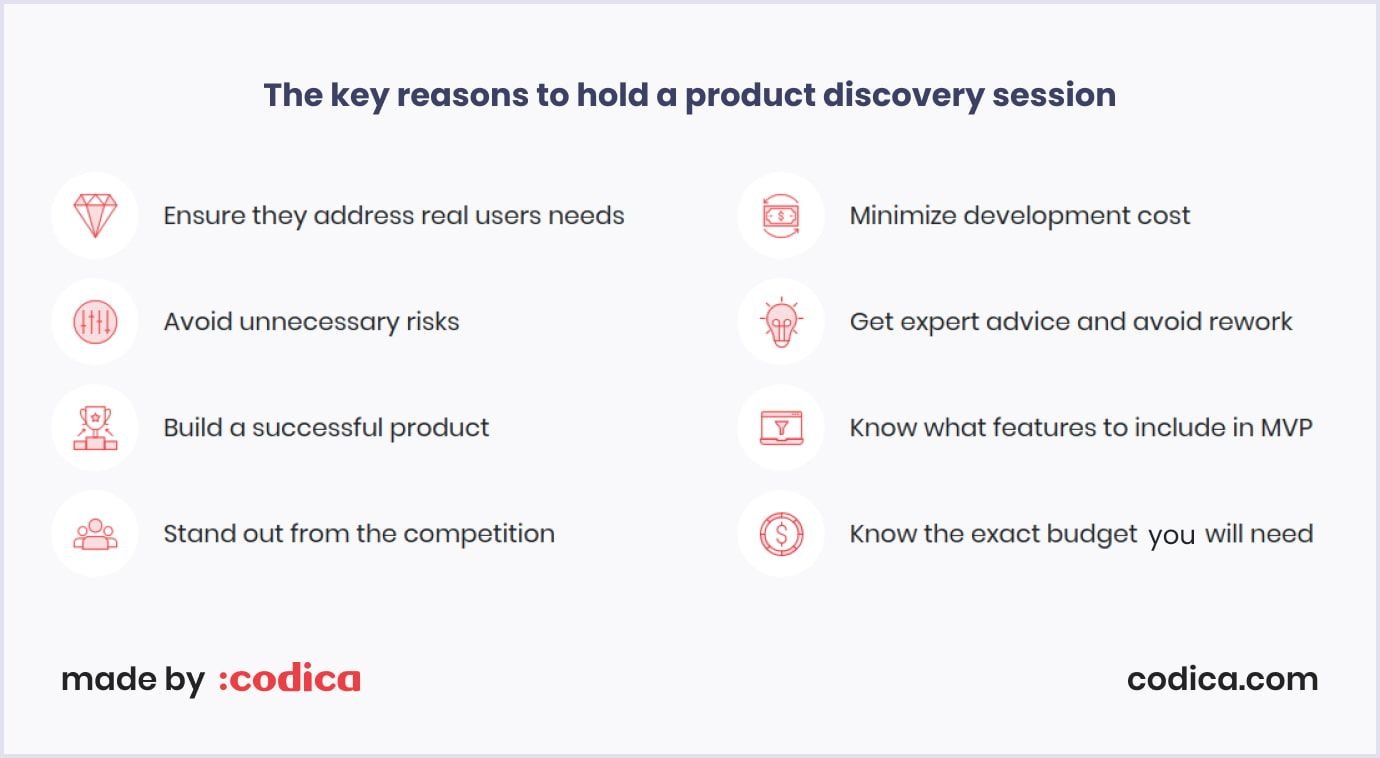
So, the main goals of the product discovery process are as follows:
- Identify the problems that the product solves;
- Discover the target audience and competitors;
- Define the project’s timeline and budget;
- Elaborate user flow;
- Create prototypes;
- Prepare a feature list, including killer features.
Since you better understand the needs of your target audience and the project’s potential, you minimize risks when launching your product. So you can deliver better results to your prospects.
Project discovery parties
Product discovery sessions serve as an umbrella for parties who discuss the project requirements. The representatives taking part in this process include the following:
- Client and their representatives who describe the purpose and requirements of the solution;
- Business analyst/product manager who collects, analyzes, and structures the data from the client;
- UI/UX designer who creates prototypes based on the information from the client and their research for custom app design;
- Lead of software engineers who suggests optimized team composition and tech stack based on research and requirements.
All of the parties contribute to creating a thorough plan for solution development. Below you can see in more detail how the sides of the product discovery process are involved in the discussion.
Materials
After the series of discussions, you will get documents with your solution's timeline, costs, and final look. These documents include the following:
- The list of primary features;
- Clickable prototypes;
- The product architecture and tech stack;
- Time and cost estimates;
- Project specification;
- Advice on team composition.
Just like in a business model canvas, these documents can be changed if you or the team see the need for this.
For example, relying on this method, we created a multi-vendor marketplace platform for B2C and C2C segments. The client wanted to create a platform where people can shop online in one place. This would save them hours and even days compared to searching for products online in different stores. Also, the aim was to make the platform engaging for customers where they could share their experience with the platform. Despite the platform's versatility, its design should be intuitive so that users can navigate through the product categories and filters.
During the detailed discovery sessions, we helped our client clarify how to implement features for displaying product categories and subcategories. We suggested how to divide the platform into sections with a simple switch in the menu.
As a result of development, the platform helps users find products in many categories. We optimized the platform for better search engine rankings. Our team elaborated on the Local and Connect sections. They make the platform more engaging as users can search for local stores and share their experiences with the platform.
Also, we created a minimalist design with convenient functions that allows you to find items quickly. Check the video below to grasp how the platform works.
Viable questions in each building block
As you fill your business model canvas template, addressing the right questions is crucial to making correct assumptions. So, we prepared a list of possible questions you can put in each of the nine blocks of a business model canvas.
These questions break each segment into smaller chunks. You can manage each broad category with these elements and get relevant answers. Feel free to adapt them to your business needs. Also, you can select some questions from the given if that suits you better.
Customer segments
- Who are your potential customers?
- What are your customers’ pain points?
Value propositions
- What sorts of products do you provide to particular groups of customers?
- What is the value you deliver to customers?
- Which customers’ problems do you solve with your products?
Channels
- Which channels are beneficial to deliver value to customers? Are you using them now?
- Are your channels cost-efficient? What channels work best?
- Do your channels suit well customers’ routine actions?
Customer relationships
- What relationships do you hold with each customer segment?
- Are those relationships costly?
- How do those relationships connect with the rest of your business model canvas?
Revenue streams
- What are the values your customers are ready to pay for?
- What are the best ways for your customers to pay for your value?
- Do revenue streams contribute to your total?
- How do you involve new financing sources, if needed?
Key resources
- What key resources do you need to run your business?
- How do they help to improve your relationships with customers?
- How do they help make channels and revenue streams advantageous?
Key activities
- What are your key activities to improve customer relationships, channels, and revenue streams?
- How do you bring up the value propositions to customers with your activities?
Key partnerships
- Who are your main partners?
- What are the resources that you gain in your partnerships?
- What are the key activities that your key partners carry out for you?
Cost structure:
- What are the expenditures necessary for your business model?
- Which activities and resources are the most expensive?
Related reading: 10 Best Marketplace Monetization Strategies to Succeed
Life after creating your business model canvas
Once you’ve created your business model canvas, you can use it in your everyday business routines. This is its purpose, to guide you in your business journey. So, how can you use your business model canvas for the best of your company?
Tracking your progress. Use your business model canvas as a statistics board reflecting your progress in particular sections. Highlight those areas that can perform better and those where you succeed.
Discussions with teams. The business model canvas is helpful for discussing it with your teams. Everyone can see the bright and dark spots and bring solutions or improvements.
A better understanding of customers. Your customers are the force that keeps your business running. When they feel your care, they are more loyal to your brand. So, you can use your business model canvas to get insights on how to build strong relationships with them.
Hiring new talent and showing it to investors. When engaging new talent, you can show them the business model canvas so they familiarize themselves with the company’s state. Also, you can use it to support your business ideas when talking to investors about attracting capital.
You may also like: MVP Development Cost: 5 Main Aspects for Aspiring Entrepreneurs
Software for creating a business model canvas
A traditional way of creating a business model canvas is to take a massive sheet of paper or a whiteboard and fill in the nine areas. But digital solutions can also help you visualize and share the template between teams. Below are several examples of prominent business model canvas software.
Strategyzer. This solution comes from the company co-founded by Alex Osterwalder. It is versatile and convenient. The tool allows you to create a business model canvas and value proposition canvas, providing real-time teamwork. An estimator tool analyzes revenue flow and calculates the business idea's viability. The tool also estimates the potential of startups with their price. The solution has convenient color marking and improved encryption. The subscription costs $300 annually, with unlimited canvases and unlimited users.
Canvanizer. The tool has been there for a while, providing an excellent experience in building business model canvases. The website also offers templates for other types of canvases, such as lean canvases and service design canvases. The team can view and share the canvas and convert it into sharable formats, such as .pdf, .png, and more.
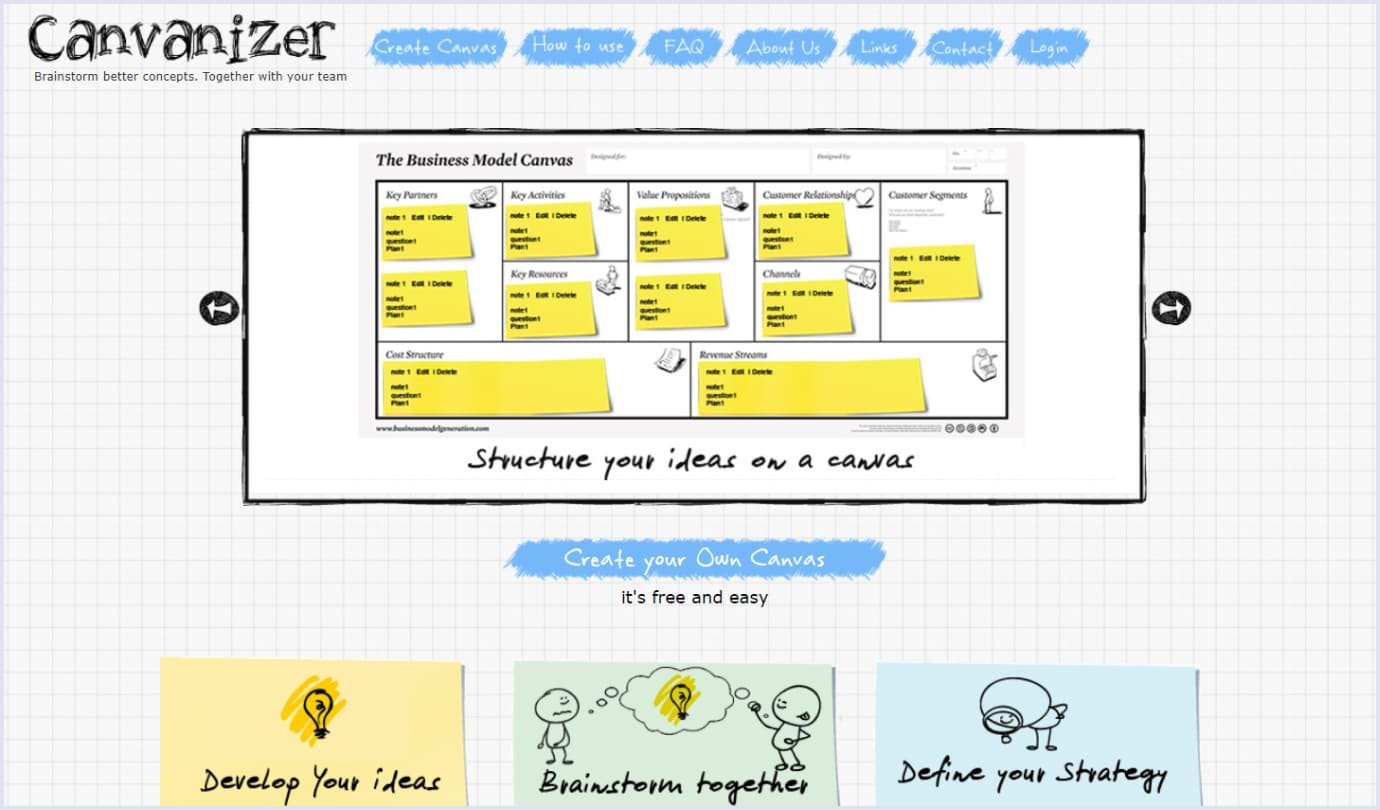
Visual Paradigm. It is a versatile set of tools for development teams' collaboration and creating diagrams. Among other visualization diagrams, the app features various templates of business model canvases. You can choose cards with different colors to mark each of the nine areas.
Miro. Miro is a whiteboard for teamwork, creating content, brainstorming, strategic planning, and more. In addition, it provides various types of templates for collaboration and business model canvas. The software allows you to select and share a template with a team. After that, anyone can contribute to developing the template by bringing their ideas. The tool also offers the option of creating canvases from scratch. The video below presents how you can create and manipulate templates in Miro.
CNVS. This software keeps the features simple and presents them with a minimalistic design. The basic set of features is free. You must pay for advanced features, such as unlimited workspaces, private canvases, and sharing with others. The software offers lean canvas, business canvas, and feature canvas templates. The basic set of templates and team collaboration tools are given for free. Yet, if you need unlimited workspaces or support, you must pay an additional monthly fee of €7.99.
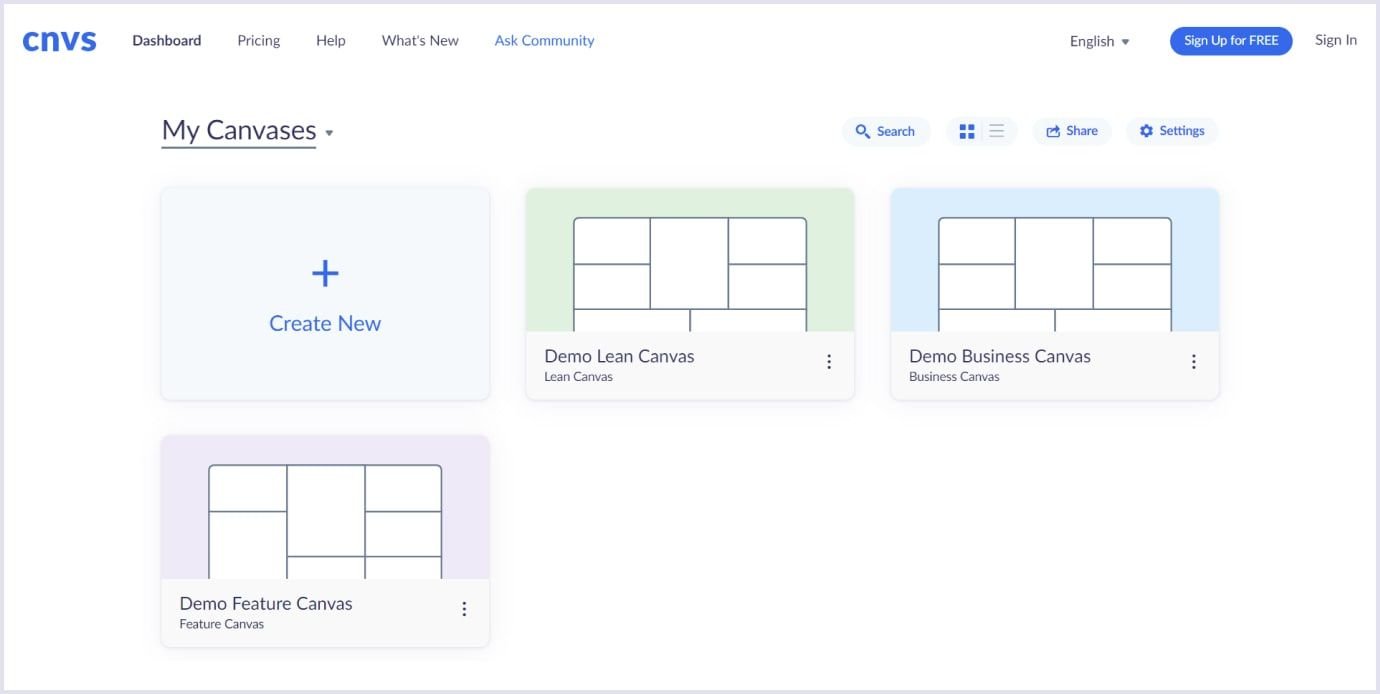
Wrapping up
As Alexander Osterwalder put it, business models have a short lifespan in an ever-changing environment. The business model canvas serves best regarding that possibility. With the evolution of your business, you can adjust the nine areas so your business performs better. This approach is ideal for modern, ever-changing market conditions where you must react quickly.
Remember also that those areas are intertwined and work as a whole. This means that changes in one sector will result in transformations in others.
However you choose to build your business model canvas, it will serve the best of your company. Let your teams share their insights and improve the business model template to keep it updated.
If you need help discovering the key points of your business project’s potential, feel free to contact us. Also, check our portfolio to see more projects that started from defining the key business points. Our experts will eagerly help you with estimating your project’s business opportunities and development.

